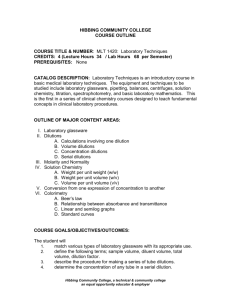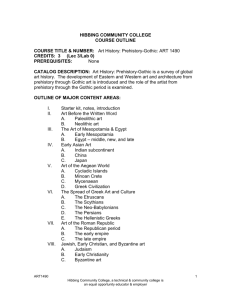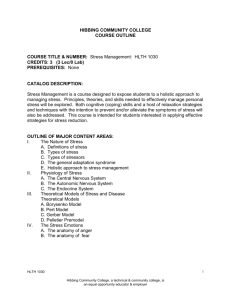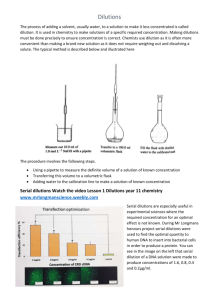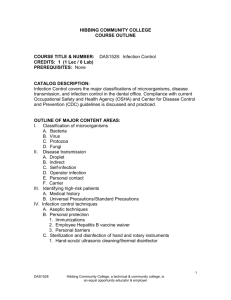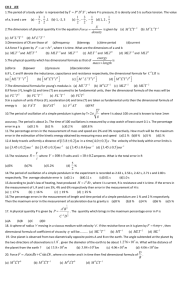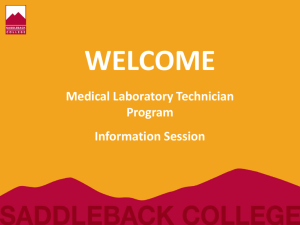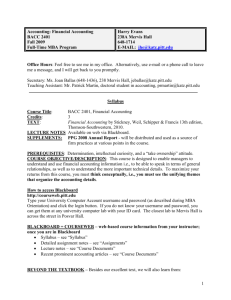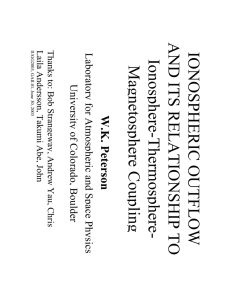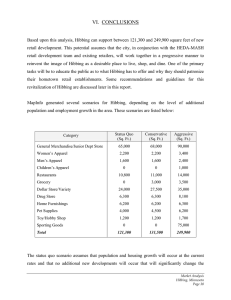HIBBING COMMUNITY COLLEGE
advertisement
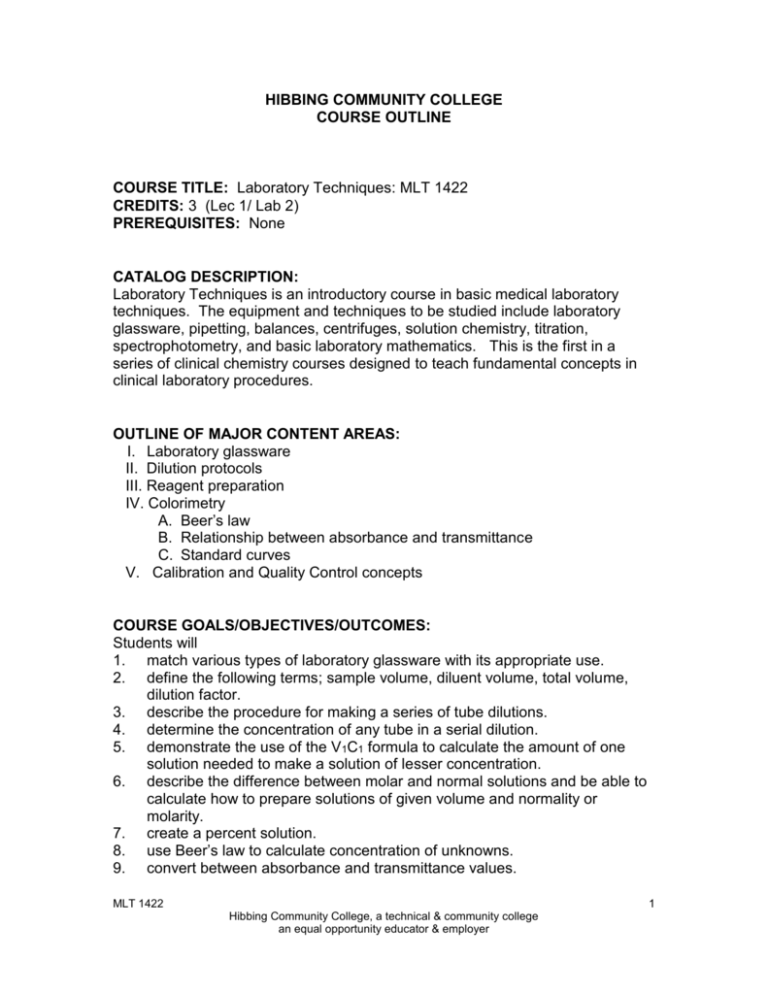
HIBBING COMMUNITY COLLEGE COURSE OUTLINE COURSE TITLE: Laboratory Techniques: MLT 1422 CREDITS: 3 (Lec 1/ Lab 2) PREREQUISITES: None CATALOG DESCRIPTION: Laboratory Techniques is an introductory course in basic medical laboratory techniques. The equipment and techniques to be studied include laboratory glassware, pipetting, balances, centrifuges, solution chemistry, titration, spectrophotometry, and basic laboratory mathematics. This is the first in a series of clinical chemistry courses designed to teach fundamental concepts in clinical laboratory procedures. OUTLINE OF MAJOR CONTENT AREAS: I. Laboratory glassware II. Dilution protocols III. Reagent preparation IV. Colorimetry A. Beer’s law B. Relationship between absorbance and transmittance C. Standard curves V. Calibration and Quality Control concepts COURSE GOALS/OBJECTIVES/OUTCOMES: Students will 1. match various types of laboratory glassware with its appropriate use. 2. define the following terms; sample volume, diluent volume, total volume, dilution factor. 3. describe the procedure for making a series of tube dilutions. 4. determine the concentration of any tube in a serial dilution. 5. demonstrate the use of the V1C1 formula to calculate the amount of one solution needed to make a solution of lesser concentration. 6. describe the difference between molar and normal solutions and be able to calculate how to prepare solutions of given volume and normality or molarity. 7. create a percent solution. 8. use Beer’s law to calculate concentration of unknowns. 9. convert between absorbance and transmittance values. MLT 1422 1 Hibbing Community College, a technical & community college an equal opportunity educator & employer 10. describe the current use of graphs and standard curves in the clinical laboratory in calculating the concentration of a substance. 11. calculate the mean, median, and mode of a set of variables. 12. define the following terms shift and random trend as they apply to a set of control values and error. 13. calculate and understand the purpose of the standard deviation and coefficient of variation of data set and how the value relates to precision accuracy. 14. explain linear limits, linear ranges, reportable ranges, and demonstrate how to handle and report samples outside these limits. 15. apply prior knowledge to problem solving including recognizing abnormal or unusual test results, recognizing, unacceptable quality control results and apply knowledge of established procedures to verify test results. 16. define the function and organization of the laboratories. 17. explain with the regulating agencies of the all the different types of laboratories. 18. describe the purpose of proficiency testing in the medical laboratory. 19. describe rare medical terminology. 20. convert english to metric units and vice versa as well as oF to oC and vice versa. 21. describe lab safety precautions in the laboratory for chemical, biological and other hazards. 22. understand the importance of quality assessment and techniques used in the laboratory. 23. locate and explain the parts of the microscope. 24. perform successful capillary and venous punctures, selecting the appropriate equipment, and identify suitable sites. 25. investigate the different departments of the laboratory and perform basic testing done in each. To include hematology, coagulation, urinalysis, chemistry and microbiology. LAB COMPETENCIES: At the conclusion of this course, the student will be able to: 1. demonstrate an understanding of when to use and proper use of: Volumetric Pipettes (TD or TC) Serological Pipettes Automatic Pipettes 2. perform dilutions and calculations on patient samples. Student obtains results that are within 5% of instructor’s results. 3. perform serial dilutions and calculations on patient samples. Student obtains results that are within 5% of instructor’s results. 4. calculate the mean, standard deviation, and coefficient of variation for a sample of test results; using this data, establish the upper and lower limits of acceptable quality control results and develop Levey-Jennings charts that reflect these QC ranges. 5. demonstrate safe and professional work habits. MLT 1422 2 Hibbing Community College, a technical & community college an equal opportunity educator & employer MNTC GOALS AND COMPETENCIES MET: N/A HCC COMPETENCIES MET: Working Productively and Cooperatively Thinking Creatively and Critically STUDENT CONTRIBUTIONS: Students are expected to participate in class lectures, complete all labs and assignments on time, and spend the necessary study time to pass all quizzes and exams. STUDENT ASSESSMENT SHALL TAKE PLACE USING INSTRUMENTS SELECTED/DEVELOPED BY THE COURSE INSTRUCTOR. SPECIAL INFORMATION: (SPECIAL FEES, DIRECTIVES ON HAZARDOUS MATERIALS): AASC APPROVAL DATE: May 15, 2013 REVIEW DATE: May 2018 MLT1422:so 051513 MLT 1422 3 Hibbing Community College, a technical & community college an equal opportunity educator & employer
